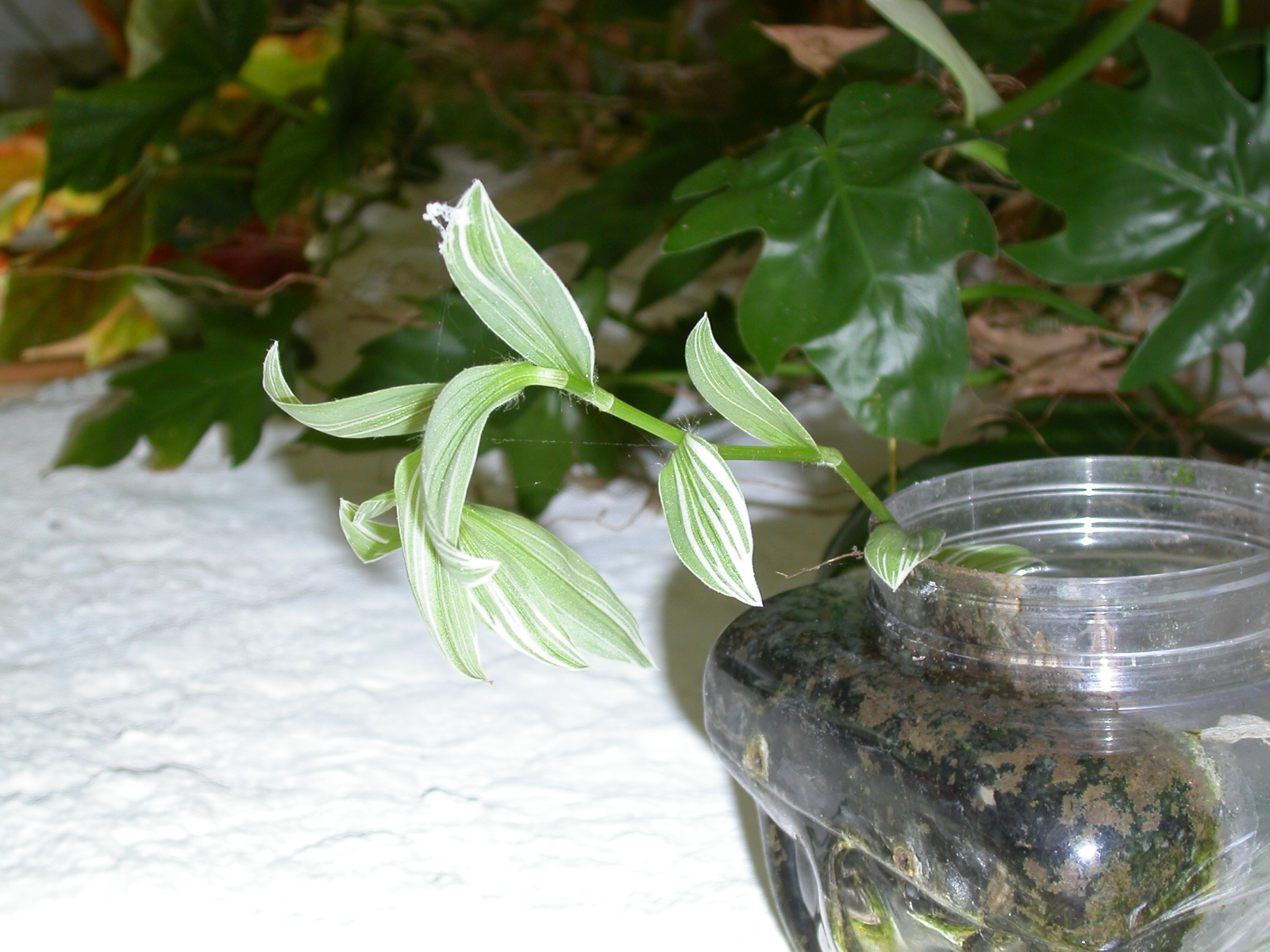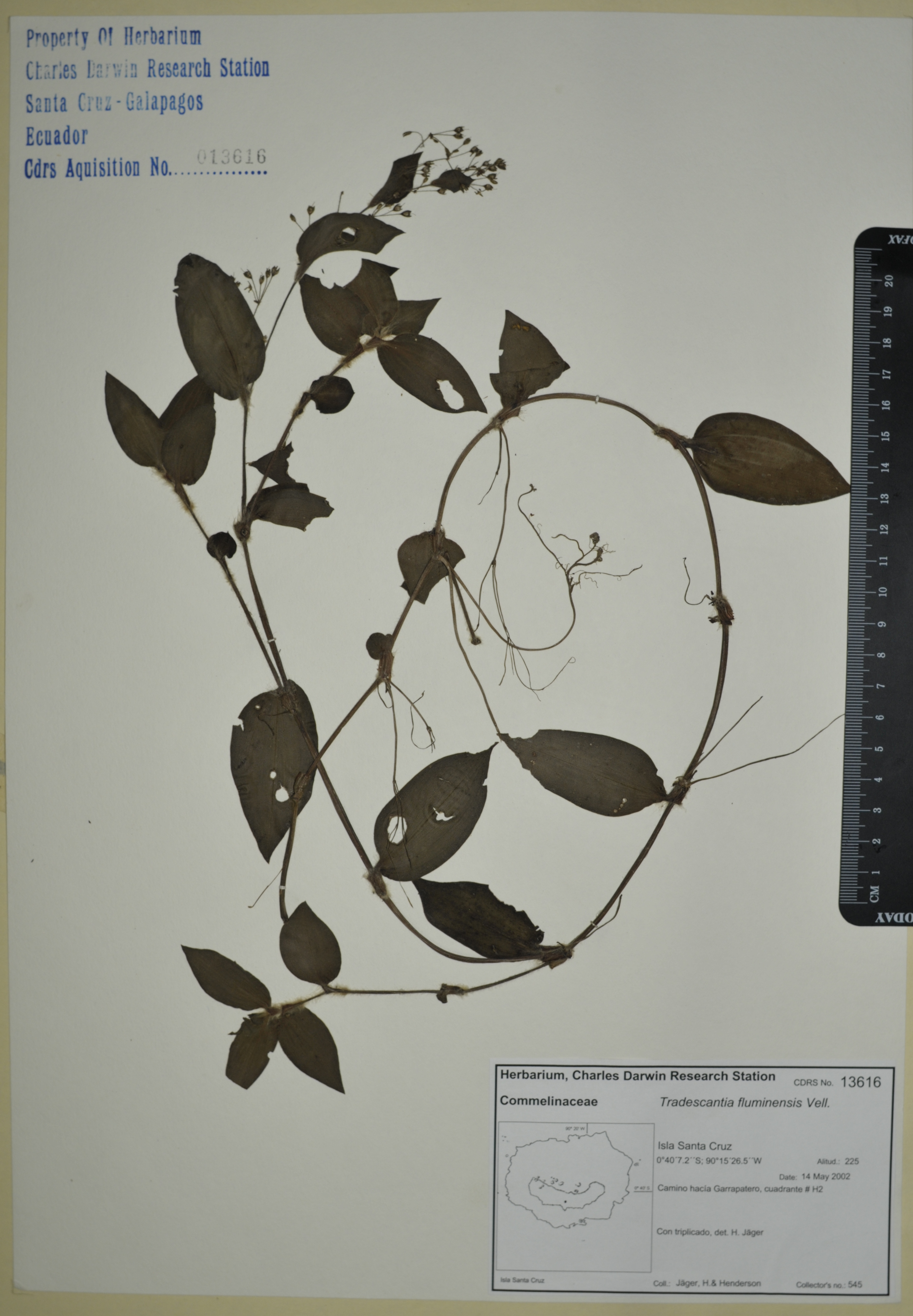Galapagos Species Database
The Galapagos Species Database shares the information about the species from our Natural History Collections.
Tradescantia fluminensis
calcha, amor de hombre, wandering jew, river spiderwort, small leaf spiderwort



The small-leaf spiderwort is a perennial creeping herb with succulent rooting stems and oval to elliptical leaves 3-6cm long. The flowers are shaped like small, white, 3-petaled stars. Small-leaf spiderwort forms a thick carpet of vegetation that can smother other plants.
T. fluminensis is a perennial creeping herb with succulent rooting stems and oval/elliptical leaves 3 to 6 cm long. It can reproduce vegetatively from broken stems or roots, and by seed. The flowers are shaped like small, white, 3 petaled stars. The species grows under the canopy forming a carpet.
Domain
Eukaryota
Kingdom
Plantae
Phylum
Magnoliophyta
Class
Liliopsida (= Monocotyledoneae)
Order
Commelinales
Family
Commelinaceae
Genus
Tradescantia
Species
fluminensis
Taxon category: Accepted
Syn.: Tradescantia albiflora Kunth
Origin: Introduced - established
Year of first record: 1985
Year of introduction: 1972
Mode of introduction: Intentional
Introduction Pathway: Intentional
Subpathway: Agriculture/Horticulture
Introduced status: Naturalized
Invasive status: Invasive
Impact in Galapagos: This species often colonizes areas where blackberry control has been carried out. It also grows under all forest canopies.
Impact elsewhere: This species forms dense ground cover, smothering many native plants in humid areas. It also prevents germination through ground coverage.
Control History in Galapagos: The species is not controlled in Galapagos, partly because it is easily confused with the native Commelina diffusa (which has a blue flower)
Control methods elsewhere: Physical: manual removal, raking or rolling or solarization using plastic sheeting. Large infestations are extremely difficult to eradicate by hand (McCluggage, 1998). Chemical: Application of the herbicide paraquat is effective in controlling infestations. Regrowth should be re-treated with follow-up applications. Other herbicides which have been used to control small-leaf spiderwort include: amitrol, glyphosate, metsulfuron methyl, and picloram (McCluggage, 1998).
Known Pest elsewhere: Widespread
Habitat preferences: Small-leaf spiderwort grows in damp shady areas of forest canopy, gullies, and riparian zones (stream and river banks). Often occurs close to human habitation.
Trophic role: Primary producer
Reproduction mode: Predominantly asexual
Reproductive biology: May disperse via seeds or vegetatively via broken stem or root pieces which are capable of re-rooting.
Growth form: Perennial Herbs
Distribution origin: South America (Argentina, Brazil, Uraguay)
Economic Use: Used as an ornamental houseplant.
Map of specimen collection localities or observation records for this species in our collections database.
Distribution: Santa Cruz, San Cristobal, Isabela; originally from South America (Argentina, Brazil, Uraguay). Present in gardens and is spreading in the National Park and agricultural zone.
- Adsersen, H. (s.a.) Personal observations Charles Darwin Research Station, unpublished Manuscript.
- Blake, S. Wikelski, M., Cabrera, F., Guézou, A., Silva, M., Sadeghayobi, E., Yackulik, C. & Jaramillo, P. (2011) Gardeners of Galapagos? Seed dispersal by giant tortoises. Journal of Biogeography (submission): 1-41.
- Flores, E. (1985) Censo de Plantas Introducidas desde el Canal de Itabaca hasta Puerto Ayora. Tesis de Ingeniero Forestal, Univ. Técnica Luis Vargas Torres, Esmeraldas: 1-132.
- Guézou, A. Trueman, M., Buddenhagen, E., Chamorro, S., Guerrero, A.M., Pozo, P., Atkinson, R. (2010) An extensive Alien Plan Inventory from the Inhabited Areas of Galapagos Plos One/ www.plosone.org. Volume 5/ Issue 4/e10276
- Jørgensen, P.M. Nee, M. & Beck, S. G. (2010) Catálogo de las plantas vasculares de Bolivia. Monogr. Syst. Bot. Missouri Bot. Gard.
- McCluggage, T. (1998) Herbicide trials on Tradescantia fluminensis Conservation Advisory Science Notes: 180. Wellington, New Zealand Department of Conservation
- Tropicos.org. (2017) Database of Missouri Botanical Garden. Tropicos.org. Missouri Botanical Garden. 06 Oct 2017 <http://www.tropicos.org
- Zuloaga, F.O. Morrone, O., Belgrano, M.J., Marticorena, C. & Marchesi, E. (2008) Catálogo de las Plantas Vasculares del Cono Sur (Argentina, Sur de Brasil, Chile, Paraguay y Urugray). Monogr. Syst. Bot. Missouri Bot. Gard. 107(1): i–xcvi, 1–983; 107(2): i–xx, 985–2286; 107(3): i–xxi, 2287–3348.
You are welcome to download and use the information found in this page, acknowledging its source.
This page should be cited as follows:
"Galapagos Species Database, Tradescantia fluminensis", dataZone. Charles Darwin Foundation, https://datazone.darwinfoundation.org/en/checklist/?species=874. Accessed 31 December 2025.


Dispersal propagule: Varius
seeds or fragments